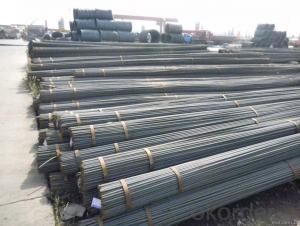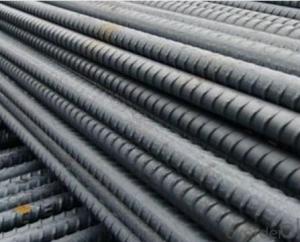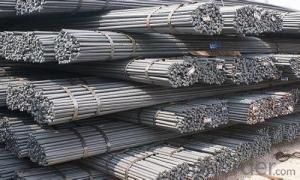G460B deformed steel bar deformed steel bar
- Loading Port:
- Tianjin
- Payment Terms:
- TT or LC
- Min Order Qty:
- 25 m.t.
- Supply Capability:
- 100000 m.t./month
OKorder Service Pledge
OKorder Financial Service
You Might Also Like
Product Description:
OKorder is offering G460B deformed steel bar deformed steel bar at great prices with worldwide shipping. Our supplier is a world-class manufacturer of steel, with our products utilized the world over. OKorder annually supplies products to European, North American and Asian markets. We provide quotations within 24 hours of receiving an inquiry and guarantee competitive prices.
Product Applications:
G460B deformed steel bar deformed steel bar are ideal for structural applications and are widely used in the construction of buildings and bridges, and the manufacturing, petrochemical, and transportation industries.
Product Advantages:
OKorder's deformed steel bar are durable, strong, and resist corrosion.
Main Product Features:
· Premium quality
· Prompt delivery & seaworthy packing (30 days after receiving deposit)
· Corrosion resistance
· Can be recycled and reused
· Mill test certification
· Professional Service
· Competitive pricing
Product Specifications:
Specifications of HRB400 Deformed Steel Bar:
Standard | GB | HRB400 | |
Diameter | 6mm,8mm,10mm,12mm,14mm,16mm,18mm,20mm, 22mm,25mm,28mm,32mm,36mm,40mm,50mm | ||
Length | 6M, 9M,12M or as required | ||
Place of origin | Hebei, China mainland | ||
Advantages | exact size, regular package, chemical and mechanical properties are stable. | ||
Type | Hot rolled deformed steel bar | ||
Brand name | DRAGON | ||
Chemical Composition: (Please kindly find our chemistry of our material based on HRB500 as below for your information)
Grade | Technical data of the original chemical composition (%) | ||||||
C | Mn | Si | S | P | V | ||
HRB400 | ≤0.25 | ≤1.60 | ≤0.80 | ≤0.045 | ≤0.045 | 0.04-0.12 | |
Physical capability | |||||||
Yield Strength (N/cm²) | Tensile Strength (N/cm²) | Elongation (%) | |||||
≥400 | ≥570 | ≥14 | |||||
Theoretical weight and section area of each diameter as below for your information:
Diameter(mm) | Section area (mm²) | Mass(kg/m) | Weight of 12m bar(kg) |
6 | 28.27 | 0.222 | 2.664 |
8 | 50.27 | 0.395 | 4.74 |
10 | 78.54 | 0.617 | 7.404 |
12 | 113.1 | 0.888 | 10.656 |
14 | 153.9 | 1.21 | 14.52 |
16 | 201.1 | 1.58 | 18.96 |
18 | 254.5 | 2.00 | 24 |
20 | 314.2 | 2.47 | 29.64 |
22 | 380.1 | 2.98 | 35.76 |
25 | 490.9 | 3.85 | 46.2 |
28 | 615.8 | 4.83 | 57.96 |
32 | 804.2 | 6.31 | 75.72 |
36 | 1018 | 7.99 | 98.88 |
40 | 1257 | 9.87 | 118.44 |
50 | 1964 | 15.42 | 185.04 |
Usage and Applications of HRB400 Deformed Steel Bar:
Deformed bar is widely used in buildings, bridges, roads and other engineering construction. Big to highways, railways, bridges, culverts, tunnels, public facilities such as flood control, dam, small to housing construction, beam, column, wall and the foundation of the plate, deformed bar is an integral structure material. With the development of world economy and the vigorous development of infrastructure construction, real estate, the demand for deformed bar will be larger and larger..
Packaging & Delivery of HRB400 Deformed Steel Bar:
Packaging Detail: products are packed in bundle and then shipped by container or bulk vessel, deformed bar is usually naked strapping delivery, when storing, please pay attention to moisture proof. The performance of rust will produce adverse effect.
Each bundle weight: 2-3MT, or as required
Payment term: TT or L/C
Delivery Detail: within 45 days after received advanced payment or LC.
Label: to be specified by customer, generally, each bundle has 1-2 labels
Trade terms: FOB, CFR, CIF
Deformed Steel Bar in container
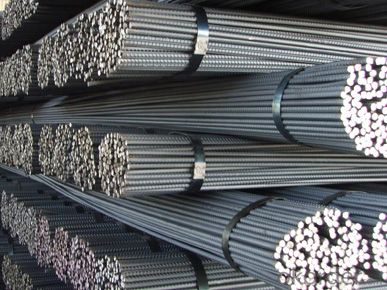
Deformed Steel Bar in factory
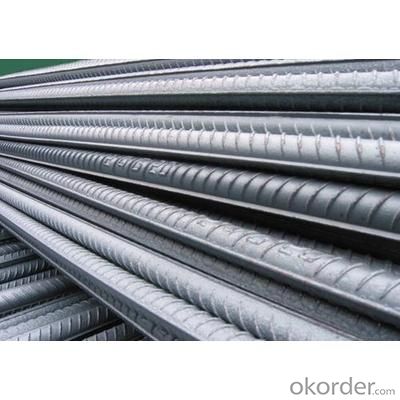
Note:
1. Our products are produced according to national standard (GB), if not, supply according to national standards (GB) or agreement as customer required.
2. Other Grade and Standard Deformed Steel Bar we can supply:
Grade: GR40/GR60, G460B/B500A/B500B/B500C,BST500S
Standard: ASTM, BS, DIN
The Minimum Order Quantity of these products is high, and need to be confirmed.
3. We can not only supply Deformed Steel Bar; if you need anything about building materials, please contact us for further information.
4. Please send us your detail specifications when inquire. We will reply to you as soon as possible. We sincerely hope we can establish a long stable business relationship.
FAQ:
Q1: How soon can we receive the product after purchase?
A1: Within three days of placing an order, we will begin production. The specific shipping date is dependent upon international and government factors, but is typically 7 to 10 workdays.
Q2: What makes stainless steel stainless?
A2: Stainless steel must contain at least 10.5 % chromium. It is this element that reacts with the oxygen in the air to form a complex chrome-oxide surface layer that is invisible but strong enough to prevent further oxygen from "staining" (rusting) the surface. Higher levels of chromium and the addition of other alloying elements such as nickel and molybdenum enhance this surface layer and improve the corrosion resistance of the stainless material.
- Q:Can steel rebars be used in structures with limited construction timeframes?
- Yes, steel rebars can be used in structures with limited construction timeframes. Steel rebars are commonly used in construction projects due to their high tensile strength, which makes them suitable for reinforcing concrete structures. They can be quickly and efficiently installed, allowing for faster construction times compared to other reinforcement materials. Additionally, steel rebars provide durability and long-term stability to the structure, ensuring its integrity even in time-constrained projects. Therefore, utilizing steel rebars can be an effective solution for structures with limited construction timeframes, as they provide both strength and speed in the construction process.
- Q:What are the main uses of threaded steel?
- The rebar is a kind of small section steel, mainly used for the skeleton of reinforced concrete construction members. Steel is usually used for reinforced concrete, its role is to increase the friction fringe, the rebar and concrete secant integrally formed together, tic phenomenon can not occur in the role of external force, improve the strength of concrete.
- Q:What is the role of steel rebars in preventing cracks in concrete structures?
- Steel rebars play a crucial role in preventing cracks in concrete structures by providing reinforcement and enhancing the overall strength and durability of the concrete. When concrete is poured, it is initially strong in compression but weak in tension. This means that concrete can withstand forces that push or compress it, but it is prone to cracking when subjected to pulling or tension forces. To counteract this weakness, steel rebars are embedded within the concrete. These rebars act as a framework, distributing and absorbing tensile forces that would otherwise cause cracks in the concrete. When the concrete experiences tension, the rebars bear the load and help redistribute the forces, preventing cracks from forming or spreading. The steel rebars also enhance the structural integrity of the concrete by increasing its resistance to bending, shear, and other types of stress. This reinforcement is particularly important in large concrete structures such as buildings, bridges, and dams, as it helps to ensure their stability and longevity. Additionally, steel rebars also play a critical role in preventing cracks in concrete due to temperature changes and shrinkage. Concrete tends to expand and contract with temperature fluctuations, and this can lead to cracking if not properly controlled. Steel rebars help to control these movements by providing restraint and minimizing the potential for cracks. Overall, the presence of steel rebars in concrete structures significantly improves their ability to resist cracking. They reinforce the concrete, enhance its tensile strength, and help distribute and control forces that may cause cracks. By effectively preventing cracks, steel rebars contribute to the long-term durability and safety of concrete structures.
- Q:How do steel rebars reinforce concrete?
- The structural stability of concrete is reinforced by steel rebars, which provide additional strength. Concrete possesses strength under compression but is weak when subjected to tension. To counteract this weakness and enhance its tensile strength, steel rebars are embedded in the concrete. The rebars function as reinforcement by absorbing the tensile forces that arise when a structure undergoes bending or stretching. In the presence of such forces, the rebars evenly distribute the load across the concrete, preventing cracks and failure. This is particularly crucial in buildings, bridges, and dams, where the concrete must withstand diverse external forces. Furthermore, the rebars help regulate the expansion and contraction of the concrete resulting from temperature changes. Since steel and concrete have similar coefficients of thermal expansion, steel rebars assist in minimizing stress caused by temperature fluctuations, thus reducing the likelihood of cracking. Additionally, the bond between the steel rebars and the concrete is vital for effective reinforcement. The rough surface of the rebars ensures excellent adherence to the surrounding concrete, enabling them to function as a composite material. This bond facilitates the transfer of stress from the concrete to the rebars, thereby enhancing the overall strength and durability of the structure. To summarize, steel rebars reinforce concrete by providing tensile strength, distributing loads, controlling temperature-induced stress, and establishing a robust bond with the concrete. The combination of concrete and steel results in a reinforced concrete structure capable of withstanding various external forces and maintaining its structural integrity over time.
- Q:What are the different types of steel rebars used in marine structures?
- The different types of steel rebars used in marine structures include epoxy-coated rebars, stainless steel rebars, and galvanized rebars.
- Q:Are steel rebars fire resistant?
- Steel rebars are generally considered to possess fire resistance. Steel, as a material, cannot burn or contribute to the spread of fire because it is incombustible. When exposed to fire, steel rebars can endure high temperatures for a prolonged duration without compromising their structural integrity. This ability is attributed to the high melting point of steel, which stands at approximately 1370 degrees Celsius (2500 degrees Fahrenheit). Moreover, during construction, steel rebars are often encased in concrete, which adds an extra layer of protection against fire. However, it is important to note that under extremely intense and long-lasting fire conditions, steel may gradually weaken and lose its ability to bear loads. Hence, fire protection measures like the application of fire-resistant coatings or fireproofing materials are sometimes implemented to further enhance the fire resistance of steel structures.
- Q:What is the role of steel rebars in ensuring occupant safety?
- Various structures, particularly buildings and infrastructure, rely on steel rebars to ensure occupant safety. These reinforced steel bars are commonly used in concrete construction to strengthen and prolong the lifespan of the structure. Ultimately, this safeguards the individuals residing or working within these structures. Steel rebars have a primary function of providing structural reinforcement to concrete elements like columns, beams, and slabs. By incorporating rebars into the concrete, the overall load-bearing capacity of the structure is greatly increased. This allows it to endure external forces and loads, significantly reducing the risk of collapse or structural failure that could harm the occupants. During seismic events, such as earthquakes, steel rebars play a crucial role in dissipating and distributing the energy exerted on the structure. The ductility and tensile strength of steel enable it to absorb and distribute seismic forces, minimizing the chances of a sudden structural failure. Consequently, occupants are protected from potential hazards associated with seismic activity. Additionally, steel rebars enhance the fire resistance of concrete structures. While concrete itself possesses good fire-resistant properties, the inclusion of steel rebars further strengthens this resistance. Steel has a high melting point and low thermal conductivity compared to other materials. This means that steel rebars can withstand high temperatures for an extended period, ensuring the building's structural integrity during a fire and providing occupants with a safe evacuation route. Furthermore, steel rebars contribute to the long-term durability and maintenance of the structure. They prevent cracks and minimize the effects of corrosion, maintaining the concrete's structural integrity over time. This ensures that occupants are not exposed to potential hazards caused by structural deterioration. In summary, the role of steel rebars in ensuring occupant safety is essential. They provide structural reinforcement, increase load-bearing capacity, enhance fire resistance, and contribute to the long-term durability of a structure. By incorporating steel rebars into concrete construction, the risk of collapse, structural failure, and other potential hazards is significantly reduced, ultimately creating a safe environment for occupants.
- Q:How do steel rebars resist alkali-silica reaction in concrete?
- Steel rebars resist alkali-silica reaction in concrete primarily due to their passive film and the alkaline environment of the concrete. When steel rebars are embedded in concrete, they form a passive film on their surface. This film acts as a protective layer that prevents direct contact between the steel and the aggressive alkali-silica reactive aggregates present in the concrete. This passive film is formed due to the high pH of the alkaline environment created by the cement in the concrete, which typically ranges between pH 12-13. This high pH helps in creating a protective oxide layer on the surface of the steel rebar, preventing it from coming into contact with the reactive elements in the aggregates. Furthermore, the alkaline environment of the concrete helps in maintaining the passivity of the steel rebars. The alkalinity of the concrete allows the passive film to remain stable and intact, providing a continuous barrier against the alkali-silica reaction. As long as the pH of the concrete remains high, the steel rebars will continue to resist the reaction. It is worth noting that the thickness and quality of the passive film on the steel rebars are crucial in ensuring their resistance to alkali-silica reaction. Any factors that can compromise the integrity of this film, such as carbonation or chloride contamination, may increase the risk of the reaction occurring. In summary, steel rebars resist alkali-silica reaction in concrete due to the presence of a passive film on their surface, which is formed by the alkaline environment of the concrete. This film acts as a protective barrier, preventing the steel from coming into direct contact with the reactive aggregates and thus, mitigating the likelihood of the reaction occurring.
- Q:What are the different types of steel rebars used in industrial constructions?
- Industrial constructions commonly utilize various types of steel rebars, which play a crucial role in reinforcing concrete structures and imparting strength and durability to the overall construction. The key types of steel rebars frequently employed in industrial constructions are as follows: 1. Mild Steel Rebars, also referred to as black steel rebars, are the most prevalent type utilized in construction. These rebars, crafted from carbon steel, possess a smooth surface. They offer adequate strength and are cost-effective, rendering them suitable for a diverse range of industrial applications. 2. High-strength Deformed Steel Rebars (HSD) exhibit ribs or deformations on their surface, enhancing their bonding with concrete. HSD rebars, composed of carbon steel, undergo thermomechanical treatment to enhance their strength. They are commonly employed in heavy-duty industrial constructions requiring higher strength. 3. Epoxy-coated Rebars are coated with an epoxy resin to safeguard them against corrosion. These rebars find common usage in areas where concrete is exposed to moisture or chemicals, such as bridges and marine structures. The epoxy coating functions as a barrier, averting corrosion and prolonging the structure's lifespan. 4. Galvanized Rebars encompass a layer of zinc coating, bestowing them with corrosion resistance. The zinc coating acts as a sacrificial layer, shielding the steel rebars from rust. These rebars are frequently employed in areas where concrete is exposed to harsh environmental conditions or in coastal regions where the risk of corrosion is elevated. 5. Stainless Steel Rebars, recognized for their exceptional corrosion resistance, are utilized in environments necessitating remarkable durability and resistance to corrosion. They commonly find application in industrial constructions exposed to aggressive chemicals, high humidity, or extreme temperatures. Each type of steel rebar possesses distinct advantages and is suitable for diverse applications based on the specific requirements of the industrial construction project. It is imperative to meticulously consider factors such as strength, corrosion resistance, and cost when selecting the apt type of steel rebar for a particular construction endeavor.
- Q:What is the average weight of a steel rebar?
- The average weight of a steel rebar can vary depending on its size and length. Steel rebars are typically sold in lengths of 20 feet and come in various diameters ranging from 3/8 inch to 1 1/4 inch. To calculate the average weight, we need to consider the density of steel, which is approximately 0.2836 pounds per cubic inch. The weight of a steel rebar can be determined by multiplying its volume (pi times the square of the diameter divided by 4, multiplied by the length) by the density of steel. For example, let's take a 1/2 inch diameter rebar with a length of 20 feet. The calculation would be as follows: 1. Convert the diameter to inches: 1/2 inch = 0.5 inches 2. Calculate the volume: (pi * 0.5^2) / 4 = 0.19635 cubic inches 3. Convert the length to inches: 20 feet = 240 inches 4. Multiply the volume by the length: 0.19635 cubic inches * 240 inches = 47.04 cubic inches 5. Multiply the volume by the density of steel: 47.04 cubic inches * 0.2836 pounds per cubic inch = 13.34 pounds Therefore, the average weight of a 1/2 inch diameter steel rebar with a length of 20 feet is approximately 13.34 pounds.
1. Manufacturer Overview |
|
|---|---|
| Location | |
| Year Established | |
| Annual Output Value | |
| Main Markets | |
| Company Certifications | |
2. Manufacturer Certificates |
|
|---|---|
| a) Certification Name | |
| Range | |
| Reference | |
| Validity Period | |
3. Manufacturer Capability |
|
|---|---|
| a)Trade Capacity | |
| Nearest Port | |
| Export Percentage | |
| No.of Employees in Trade Department | |
| Language Spoken: | |
| b)Factory Information | |
| Factory Size: | |
| No. of Production Lines | |
| Contract Manufacturing | |
| Product Price Range | |
Send your message to us
G460B deformed steel bar deformed steel bar
- Loading Port:
- Tianjin
- Payment Terms:
- TT or LC
- Min Order Qty:
- 25 m.t.
- Supply Capability:
- 100000 m.t./month
OKorder Service Pledge
OKorder Financial Service
Similar products
New products
Hot products
Hot Searches
Related keywords







